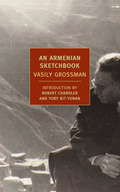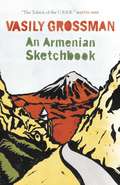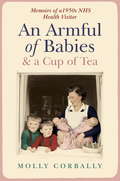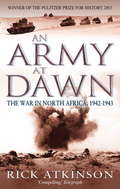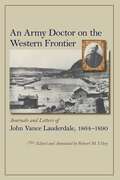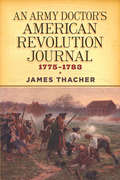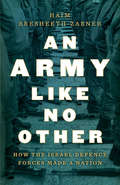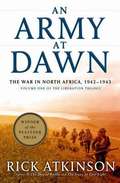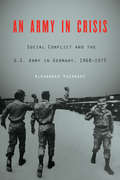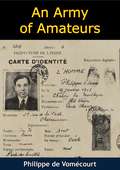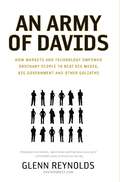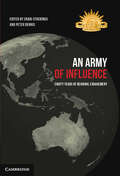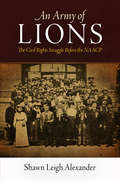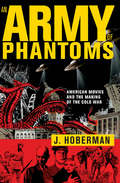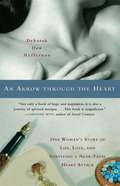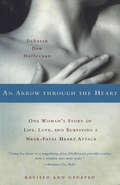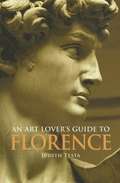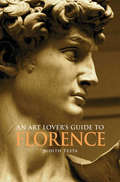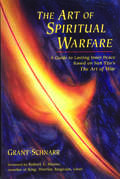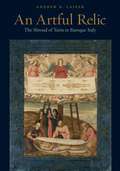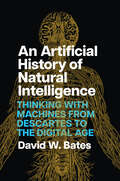- Table View
- List View
An Armenian Sketchbook
by Robert Chandler Elizabeth Chandler Vasily Grossman Yury Bit-YunanAn NYRB Classics OriginalFew writers had to confront as many of the last century's mass tragedies as Vasily Grossman, who wrote with terrifying clarity about the Shoah, the Battle of Stalingrad, and the Terror Famine in the Ukraine. An Armenian Sketchbook, however, shows us a very different Grossman, notable for his tenderness, warmth, and sense of fun. After the Soviet government confiscated--or, as Grossman always put it, "arrested"--Life and Fate, he took on the task of revising a literal Russian translation of a long Armenian novel. The novel was of little interest to him, but he needed money and was evidently glad of an excuse to travel to Armenia. An Armenian Sketchbook is his account of the two months he spent there. This is by far the most personal and intimate of Grossman's works, endowed with an air of absolute spontaneity, as though he is simply chatting to the reader about his impressions of Armenia--its mountains, its ancient churches, its people--while also examining his own thoughts and moods. A wonderfully human account of travel to a faraway place, An Armenian Sketchbook also has the vivid appeal of a self-portrait. the censors' demand. As a result, An Armenian Sketchbook was published only posthumously. A bowdlerized Russian text was published in 1967 and a complete text in 1988. This is the first English translation.
An Armenian Sketchbook
by Vasily GrossmanFew writers had to confront so many of the last century's mass tragedies as Vasily Grossman. He is likely to be remembered, above all, for the terrifying clarity with which he writes about the Shoah, the Battle of Stalingrad and the Terror Famine in the Ukraine. An Armenian Sketchbook, however, shows us a very different Grossman; it is notable for its warmth, its sense of fun and for the benign humility that is always to be found in his writing. After the 'arrest' - as Grossman always put it - of Life and Fate, Grossman took on the task of editing a literal Russian translation of a lengthy Armenian novel. The novel was of little interest to him, but he was glad of an excuse to travel to Armenia. This is his account of the two months he spent there. It is by far the most personal and intimate of Grossman's works, with an air of absolute spontaneity, as though Grossman is simply chatting to the reader about his impressions of Armenia - its mountains, its ancient churches and its people.
An Armful of Babies and a Cup of Tea: Memoirs of a 1950s Health Visitor
by Molly CorballyFor all fans of Call the Midwife - a touching memoir of a young health visitor in postwar England.After serving as a nurse in WW2, Molly Corbally joined the brand new NHS and became one of the first official District Health Visitors, attending to mothers and babies from all walks of life in the picturesque village near Coventry she came to call home. Social work was uncharted territory at the time, and Britain was very much worse for wear - TB, polio, measles and whooping cough were just some of the hazards new babies faced. Social conditions could also add to the problems, at a time when poverty and alcoholism were rife. Armed with only her nursing training, her common sense and a desire to serve, Molly set out to win over a community and provide a new and valuable service in times of great change. As well as the challenges there was also joy and laughter, from the woman who finally had a baby after fifteen years of trying, to the woman who thought she should use marmalade as nappy cream, because the hospital had never taken the label off the jar they were using to store it.Warm, witty and moving, An Armful of Babies is a vivid portrait of rural England in the post-war years, and a testament to an NHS in its own infancy and to what hasn't changed: the bond between parents and their children, and the importance of protecting that.
An Armful of Babies and a Cup of Tea: Memoirs of a 1950s NHS Health Visitor
by Molly CorballyA touching and warm-hearted memoir of a young health visitor in postwar England, for fans of Call the Midwife and The Language of Kindness.After serving as a nurse in WW2, Molly Corbally joined the brand new NHS and became one of the first official District Health Visitors, attending to mothers and babies from all walks of life in the picturesque village near Coventry she came to call home. Social work was uncharted territory at the time, and Britain was very much worse for wear - TB, polio, measles and whooping cough were just some of the hazards new babies faced. Social conditions could also add to the problems, at a time when poverty and alcoholism were rife. Armed with only her nursing training, her common sense and a desire to serve, Molly set out to win over a community and provide a new and valuable service in times of great change. As well as the challenges there was also joy and laughter, from the woman who finally had a baby after fifteen years of trying, to the woman who thought she should use marmalade as nappy cream, because the hospital had never taken the label off the jar they were using to store it.Warm, witty and moving, An Armful of Babies is a vivid portrait of rural England in the post-war years, a testament to an NHS in its own infancy and a celebration of nurses and midwives. Their tireless care saves lives, and we need them now more than ever.
An Armful of Babies and a Cup of Tea: Memoirs of a 1950s NHS Health Visitor
by Molly CorballyFor all fans of Call the Midwife - a touching memoir of a young health visitor in postwar England (from the 1940s to the 1970s). After serving as a nurse in WW2, Molly Corbally joined the brand new NHS and became one of the first official District Health Visitors, attending to mothers and babies from all walks of life in the picturesque village near Coventry she came to call home. Social work was uncharted territory at the time, and Britain was very much worse for wear - TB, polio, measles and whooping cough were just some of the hazards new babies faced. Social conditions could also add to the problems, when poverty and alcoholism were rife. Armed with only her nursing training, her common sense and a desire to serve, Molly set out to win over a community and provide a new and valuable service in times of great change. As well as the challenges there was also joy and laughter, from the woman who finally had a baby after fifteen years of trying, to the woman who thought she should use marmalade as nappy cream, because the hospital had never taken the label off the jar they were using to store it.Warm, witty and moving, An Armful of Babies is a vivid portrait of rural England in the post-war years, and a testament to an NHS in its own infancy and to what hasn't changed: the bond between parents and their children, and the importance of protecting that.(P)2018 Hodder & Stoughton Limited
An Army At Dawn: The War in North Africa, 1942-1943 (Liberation Trilogy #1)
by Rick AtkinsonThe liberation of Europe and the destruction of the Third Reich is a story of courage and enduring triumph, of calamity and miscalculation. In this first volume of the Liberation Trilogy, Rick Atkinson shows why no modern reader can understand the ultimate victory of the Allied powers without a grasp of the great drama that unfolded in North Africa in 1942 and 1943.Beginning with the daring amphibious invasion in November 1942, An Army at Dawn follows the British and American armies as they fight the French in Morocco and Algeria, and then take on the Germans and Italians in Tunisia. Battle by battle, an inexperienced and sometimes poorly led army gradually becomes a superb fighting force. Central to the tale are the extraordinary but fallible commanders who come to dominate the battlefield: Eisenhower, Patton, Bradley, Montgomery and Rommel.
An Army Doctor on the Western Frontier: Journals and Letters of John Vance Lauderdale, 1864-1890
by Robert M. UtleyAssigned to the District of Utah during the Civil War, physician John Vance Lauderdale spent the next twenty-five years on army posts in the American West, serving in California, Arizona, New Mexico, South Dakota, and Texas. Throughout his career he kept a detailed journal and sent long letters home to his sister in upstate New York. This selection of Lauderdale&’s writings, edited and annotated by a premier historian of the American West, offers an insightful account of army life that will teach readers much about the settlement and growth of the West in a time of rapid change.Lauderdale&’s observations are keen and critical. He writes about fellow officers, his army superiors, the civilians and American Indians he encountered, life on officers&’ row, and the day-to-day functioning of the army medical service. Particularly valuable are his insights into military interactions with local communities of Mormons, American Indians, and Hispanos.
An Army Doctor's American Revolution Journal, 1775–1783 (Dover Military History, Weapons, Armor)
by James ThacherAt the age of 21, James Thacher (1754–1844) joined the newly formed American army as a surgeon's mate, eventually advancing to the role of surgeon for the Massachusetts 16th Regiment. In 1823, he published his Journal, reporting both wartime events he witnessed and those he heard about during his service. One of the most valuable and entertaining accounts to have survived the Revolution, Thacher's diary vividly conveys the tumultuous spirit of the era.Thacher's eyewitness reports include the siege of Boston, the hanging of British major John André, and the momentous defeats of the British Army at Saratoga and Yorktown. His direct and vivid observations range from parties where he and his fellow officers were handsomely entertained by supporters of the new nation's army to hardscrabble days when there was little to eat and nowhere to keep warm. With its cogent overview of the war's major campaigns and battles, its insights into the character of Revolutionary leaders, and its firsthand views of the daily life of a Continental Army officer, the Journal provides a heightened sense of the drama and excitement of the Revolution.
An Army Like No Other: How the Israel Defense Forces Made a Nation
by Haim Bresheeth-ZabnerA history of the IDF that argues that Israel is a nation formed by its army.The Israeli army, officially named the Israel Defence Forces (IDF), was established in 1948 by David Ben-Gurion, Israel's first prime minister, who believed that 'the whole nation is the army'. In his mind, the IDF was to be an army like no other. It was the instrument that might transform a diverse population into a new people. Since the foundation of Israel, therefore, the IDF has been the largest, richest and most influential institution in Israel's Jewish society and is the nursery of its social, economic and political ruling class. In this fascinating history, Bresheeth charts the evolution of the IDF from the Nakba to the continued assaults upon Gaza, and shows that the state of Israel has been formed out of its wars. He also gives an account of his own experiences as a young conscript during the 1967 war. He argues that the army is embedded in all aspects of daily life and identity. And that we should not merely see it as a fighting force enjoying an international reputation, but as the central ideological, political and financial institution of Israeli society. As a consequence, we have to reconsider our assumptions on what any kind of peace might look like.
An Army at Dawn: The War in North Africa, 1942-1943 (Liberation Trilogy #1)
by Rick AtkinsonThe liberation of Europe and the destruction of the Third Reich is a story of courage and enduring triumph, of calamity and miscalculation. In this first volume of the Liberation Trilogy, Rick Atkinson shows why no modern reader can understand the ultimate victory of the Allied powers without a grasp of the great drama that unfolded in North Africa in 1942 and 1943. That first year of the Allied war was a pivotal point in American history, the moment when the United States began to act like a great power.<P><P> Beginning with the daring amphibious invasion in November 1942, An Army at Dawn follows the American and British armies as they fight the French in Morocco and Algeria, and then take on the Germans and Italians in Tunisia. Battle by battle, an inexperienced and sometimes poorly led army gradually becomes a superb fighting force. Central to the tale are the extraordinary but fallible commanders who come to dominate the battlefield: Eisenhower, Patton, Bradley, Montgomery, and Rommel.<P> Brilliantly researched, rich with new material and vivid insights, Atkinson's narrative provides the definitive history of the war in North Africa.<P> Pulitzer Prize Winner
An Army in Crisis: Social Conflict and the U.S. Army in Germany, 1968–1975
by Alexander VazanskyFollowing the decision to maintain 250,000 U.S. troops in Germany after the Allied victory in 1945, the U.S. Army had, for the most part, been a model of what a peacetime occupying army stationed in an ally’s country should be. The army had initially benefited from the positive results of U.S. foreign policy toward West Germany and the deference of the Federal Republic toward it, establishing cordial and even friendly relations with German society. By 1968, however, the disciplined military of the Allies had been replaced with rundown barracks and shabby-looking GIs, and U.S. bases in Germany had become a symbol of the army’s greatest crisis, a crisis that threatened the army’s very existence. In An Army in Crisis Alexander Vazansky analyzes the social crisis that developed among the U.S. Army forces stationed in Germany between 1968 and 1975. This crisis was the result of shifting deployment patterns across the world during the Vietnam War; changing social and political realities of life in postwar Germany and Europe; and racial tensions, drug use, dissent, and insubordination within the U.S. Army itself, influenced by the civil rights movement, the Vietnam War, and the youth movement in the States. With particular attention to 1968, An Army in Crisis examines the changing relationships between American and German soldiers, from German deference to familiarity and fraternization, and the effects that a prolonged military presence in Germany had on American military personnel, their dependents, and the lives of Germans. Vazansky presents an innovative study of opposition and resistance within the ranks, affected by the Vietnam War and the limitations of personal freedom among the military during this era.
An Army of Amateurs
by Philippe De VomécourtThis book is the fascinating firsthand account of SOE agent Philippe Vomécourt's wartime experiences and records the heroic efforts in the French resistance in Nazi-dominated France."Many books dealing with the work of the French Resistance have been published on this side of the Channel. Most of them have been the personal stories of gallant men and women, illuminating that corner of the picture that they saw. Here in Monsieur de Vomécourt's book is a wider frame of reference which enables us to see how the spirit and forces of Resistance grew in France first into a gadfly nuisance and ultimately into a serious threat to German security. It shows, too, what it meant to be a member of the Resistance, and what it cost in blood and tears.Monsieur de Vomécourt is in a good position to tell this story. He was in at the beginning in June 1940 with his brothers. Indeed, they can fairly claim to have been the first organizers and leaders, and Monsieur de Vomécourt tells a truly remarkable story.
An Army of Davids: How Markets and Technology Empower Ordinary People to Beat Big Media, Big Government, and Other Goliaths
by Glenn ReynoldsThere was a time in the not-too-distant past when large companies and powerful governments reigned supreme over the little guy. But new technologies are empowering individuals like never before, and the Davids of the world-the amateur journalists, musicians, and small businessmen and women-are suddenly making a huge economic and social impact. In Army of Davids, author Glenn Reynolds, the man behind the immensely popular Instapundit.com, provides an in-depth, big-picture point-of-view for a world where the small guys matter more and more. Reynolds explores the birth and growth of the individual's surprisingly strong influence in: arts and entertainment, anti-terrorism, nanotech and space research, and much more. The balance of power between the individual and the organization is finally evening out. And it's high time the Goliaths of the world pay attention, because, as this book proves, an army of Davids is on the rise. Endorsements: "George Orwell feared that technology would enable dictators to enslave the masses. Glenn Reynolds shows that technology can empower individuals to determine their own futures and to defeat those who would enslave us. This is a book of profound importance-and also a darn good read." -MICHAEL BARONE, senior writer at U.S. News & World Report and author of Hard America, Soft America "Blogger extraordinaire Glenn Reynolds shows how average Americans can use new technologies to overcome the twin demons of corporate greed and incompetent government. Reynolds is a compelling evangelist for the power of the individual to change our world." -ARIANNA HUFFINGTON, author of Pigs at the Trough and Fanatics and Fools "A smart, fun tour of a major social and economic trend. From home-brewed beer to blogging, Glenn Reynolds is an engaging, uniquely qualified guide to the do-it-yourself movements transforming business, politics, and media." -VIRGINIA POSTREL, Forbes columnist and author of The Future and its Enemies and The Substance of Style "A student in her dorm room now commands the resources of a multi-million dollar music recording or movie editing studio of not so many years ago. The tools of creativity have been democratized and the tools of production are not far behind (Karl Marx take note). Glenn Reynolds's beguiling new book tells the insightful story of how an 'army of Davids' is inheriting the Earth, leaving a trail of obsolete business models not to mention cultural, economic, and political institutions in its wake." -RAY KURZWEIL, scientist, inventor, and author of several books including The Singularity is Near 'Must-read,' 'gotta have,' 'culture-changing' . . . I am suspicious of blurbs with such overused plugs. But Glenn Reynolds's An Army of Davids is in fact a must-read new book that you gotta have if you are going to understand the culture-changing forces that are unleashed and at work across the globe. -HUGH HEWITT, syndicated talk radio host and author of Blog and Painting the Map Red "Glenn Reynolds has written an essential book for understanding how technology and markets are creating a bottom-up shift in power to ordinary people that is changing business, government, and our world. Packed with fresh ideas and adorned with graceful prose, An Army of Davids is a masterpiece." -JOE TRIPPI, author of The Revolution Will Not Be Televised
An Army of Influence: Eighty Years of Regional Engagement
by Peter Dennis Craig StockingsThe importance of regional cooperation is becoming more apparent as the world moves into the third decade of the 21st century. An Army of Influence is a thought-provoking analysis of the Australian Army's capacity to change, with a particular focus on the Asia-Pacific region. Written by highly regarded historians, strategists and practitioners, this book examines the Australian Army's influence abroad and the lessons it has learnt from its engagement across the Asia-Pacific region. It also explores the challenges facing the Australian Army in the future and provides principles to guide operational, administrative and modernisation planning. Containing full-colour maps and images, An Army of Influence will be of interest to both the wider defence community and general readers. It underscores the importance of maintaining an ongoing presence in the region and engages with history to address the issues facing the Army both now and into the future.
An Army of Lions
by Shawn Leigh AlexanderIn January 1890, journalist T. Thomas Fortune stood before a delegation of African American activists in Chicago and declared, "We know our rights and have the courage to defend them," as together they formed the Afro-American League, the nation's first national civil rights organization. Over the next two decades, Fortune and his fellow activists organized, agitated, and, in the process, created the foundation for the modern civil rights movement.An Army of Lions: The Civil Rights Struggle Before the NAACP traces the history of this first generation of activists and the organizations they formed to give the most comprehensive account of black America's struggle for civil rights from the end of Reconstruction to the formation of the National Association for the Advancement of Colored People in 1909. Here a host of leaders neglected by posterity--Bishop Alexander Walters, Mary Church Terrell, Jesse Lawson, Lewis G. Jordan, Kelly Miller, George H. White, Frederick McGhee, Archibald Grimké--worked alongside the more familiar figures of Ida B. Wells-Barnett, W. E. B. Du Bois, and Booker T. Washington, who are viewed through a fresh lens.As Jim Crow curtailed modes of political protest and legal redress, members of the Afro-American League and the organizations that formed in its wake--including the Afro-American Council, the Niagara Movement, the Constitution League, and the Committee of Twelve--used propaganda, moral suasion, boycotts, lobbying, electoral office, and the courts, as well as the call for self-defense, to end disfranchisement, segregation, and racial violence. In the process, the League and the organizations it spawned provided the ideological and strategic blueprint of the NAACP and the struggle for civil rights in the twentieth century, demonstrating that there was significant and effective agitation during "the age of accommodation."
An Army of Phantoms: American Movies and the Making of the Cold War
by J. HobermanThe film critic&’s sweeping analysis of American cinema in the Cold War era is both &“utterly compulsive reading [and] majestic&” in its &“breadth and rigor&” (Film Comment). An Army of Phantoms is a major work of film history and cultural criticism by leading film critic J. Hoberman. Tracing the dynamic interplay between politics and popular culture, Hoberman offers &“the most detailed year-by-year look at Hollywood during the first decade of the Cold War ever published, one that takes film analysis beyond the screen and sets it in its larger political context&” (Los Angeles Review of Books). By &“tell[ing] the story not just of what&’s on the screen but of what played out behind it,&” Hoberman demonstrates how the nation&’s deep-seated fears and wishes were projected onto the big screen. In this far-reaching work of historical synthesis, Cecil B. DeMille rubs shoulders with Douglas MacArthur, atomic tests are shown on live TV, God talks on the radio, and Joe McCarthy is bracketed with Marilyn Monroe (The American Scholar). From cavalry Westerns to apocalyptic sci-fi flicks, and biblical spectaculars; from movies to media events, congressional hearings and political campaigns, An Army of Phantoms &“remind[s] you what criticism is supposed to be: revelatory, reflective and as rapturous as the artwork itself&” (Time Out New York). &“An epic . . . alternately fevered and measured account of what might be called the primal scene of American cinema.&” —Cineaste &“There&’s something majestic about the reach of Hoberman&’s ambitions, the breadth and rigor of his research, and especially the curatorial vision brought to historical data.&” —Film Comment
An Arrow Through The Heart
by Deborah Dew HeffernanWhat if, like most women, you were overwhelmed by the struggle to balance work and family? So you did everything to be healthy and stress-free -- ate right, kept fit, never smoked, practiced yoga. And what if, out of the blue, your body betrayed you? Like most American women, Deborah Daw Heffernan worried about breast cancer, not heart disease, the nation's number-one killer of women. Yet on May 12, 1997, Deborah, a slim and health-conscious executive in her mid-forties, was stricken by a near-fatal heart attack in her weekly yoga class. There was no warning and no family history of heart disease. There was only the sudden explosion inside her chest. After emergency surgery and a harrowing string of complications, Deborah faced a long and uncertain recovery, overshadowed by the looming prospect of a heart transplant. An Arrow Through the Heart is her unflinching, soulful, and surprisingly funny chronicle of that first year -- which might easily have been her last. Anchored by the rugged landscape of Maine, by the fierce love of her husband, and by their two estranged families, who dropped everything to rally around her, she learned to do simple things all over again, one breath at a time. Ultimately, it was a year of healing both body and soul, of "finding meaning everywhere, like Easter eggs." This book is about how illness, oddly enough, can give life back to us. For the tens of thousands with cardiac disease, it will be a welcome companion on the road to recovery. For the rest of us, Deborah offers a powerful testament to the unexpected joy that can come from living in a state of impermanence.
An Arrow Through the Heart
by Deborah Daw HeffernanIn the words of Mehmet Oz, MD: "An Arrow Through the Heart is an epiphany for women who mistakenly believe that they are immune from the ravages of heart disease. Using her heart as a magnifying glass, Deborah Daw Heffernan provides readers with a window into their souls." This groundbreaking memoir was first mentioned on Oprah Winfrey's life-saving 2002 show announcing cardiovascular disease as a leading cause of death among young women. That tragic fact is still true. With both depth and humor, Deborah Daw Heffernan recounts her first year of recovery from the massive heart attack that ambushed her in a gentle yoga class--during the prime of her life and despite her impeccable health history. Ranging from high-stakes action in the OR at Massachusetts General Hospital in Boston to quietly unfolding seasons on a lake in Maine, An Arrow Through the Heart is a moving and informative story of what it takes to find one's own path to true healing. Ultimately, Heffernan combines allopathic and complementary medicine to create a sensible recovery strategy for our times. She touchingly describes her husband's devotion and the toll that her cardiovascular disease takes on him, as well as how he, too, grew from the experience. Weaving their story with the lives of family and friends, Heffernan demonstrates how illness can be transformative for all involved. Not only an empowering companion for cardiac patients, this medical classic is a guide to recovery from catastrophic change of any kind. Above all, it is a powerful testament to the unexpected joy that can come from leading a life of acknowledged impermanence. Updates include cardiovascular data for today's reader, links to the author's website and other resources, a new section on SCAD (spontaneous coronary artery dissection), and-- spoiler alert--a heart transplant in 2006. All author's proceeds are donated to cardiac causes. Deborah Daw Heffernan is a graduate of Georgetown and Harvard Universities. She has worked as a teacher in Switzerland, an associate dean at Boston University, and a freelance writer. For fourteen years she was vice president of a leading Boston-based corporate training/consulting firm--until a near-fatal heart attack changed her life forever. She lives with her husband, Jack, on a small lake in Maine.
An Art Lover's Guide to Florence
by Judith TestaThe sheer number and proximity of works of painting, sculpture, and architecture in Florence can be so overwhelming that Florentine hospitals treat hundreds of visitors each year for symptoms brought on by trying to see them all, an illness famously identified with the French author Stendhal.
An Art Lover's Guide to Florence
by Judith TestaNo city but Florence contains such an intense concentration of art produced in such a short span of time. The sheer number and proximity of works of painting, sculpture, and architecture in Florence can be so overwhelming that Florentine hospitals treat hundreds of visitors each year for symptoms brought on by trying to see them all, an illness famously identified with the French author Stendhal. While most guidebooks offer only brief descriptions of a large number of works, with little discussion of the historical background, Judith Testa gives a fresh perspective on the rich and brilliant art of the Florentine Renaissance in An Art Lover's Guide to Florence. Concentrating on a number of the greatest works, by such masters as Botticelli and Michelangelo, Testa explains each piece in terms of what it meant to the people who produced it and for whom they made it, deftly treating the complex interplay of politics, sex, and religion that were involved in the creation of those works. With Testa as a guide, armchair travelers and tourists alike will delight in the fascinating world of Florentine art and history.
An Art of Spiritual Warfare
by Robert L. Moore Grant Schnarr"Grant Schnarr's words pour forth with an eloquence born of integrity. Here is truly a spiritual autobiography, written with the passion and experience of a man who knows the terrain of the spiritual battlefront, understands the tactics of the enemy, and wages Holy War-- that is, a war of love. He is an inspiring friend to all, rousing us to join the battle and share in the victory. And in the end, when the smoke and dust have cleared, we discover that, in a miraculous way, our lives have shifted from being self-centered to being spirit-centered."-- Ray Silverman, PhD, editor, Helen Keller's Light in My DarknessWarriors do not always wear armor. Sometimes they wear three-piece suits or denim. Nowadays, thousands of people search Sun Tzu's ancient war manual for business strategies. Grant Schnarr goes deeper, finding in the old general's savvy a wealth of wisdom about how to defeat our one true enemy---our own negativity. Here are brilliant tactics for enlisting our higher powers and outwitting our tendency toward self-destruction. Whether you fight addiction, depression, a debilitating fear, or a quick temper, Grant's penetrating insights impart courage. His unflinching honesty, often funny stories, and practical exercises can help anyone make peace at home, at work, and in the private depths of being.
An Art of Spiritual Warfare
by Grant Schnarr Robert L MooreNowadays, people search Sun Tsu's ancient war manual for business strategies. Going deeper, Grant Schnarr finds how to defeat our true enemy- our own negativity. Read by rock stars and military generals, here are brilliant tactics for enlisting higher powers, outwitting self-destruction, and championing integrity and love.
An Artful Relic: The Shroud of Turin in Baroque Italy
by Andrew R. CasperIn 1578, a fourteen-foot linen sheet bearing the faint bloodstained imprint of a human corpse was presented to tens of thousands of worshippers in Turin, Italy, as one of the original shrouds used to prepare Jesus Christ’s body for entombment. From that year into the next century, the Shroud of Turin emerged as Christianity’s preeminent religious artifact. In an unprecedented new look, Andrew R. Casper sheds new light on one of the world’s most famous and controversial religious objects.Since the early twentieth century, scores of scientists and forensic investigators have attributed the Shroud’s mysterious images to painterly, natural, or even supernatural forces. Casper, however, shows that this modern opposition of artifice and authenticity does not align with the cloth’s historical conception as an object of religious devotion. Examining the period of the Shroud’s most enthusiastic following, from the late 1500s through the 1600s, he reveals how it came to be considered an artful relic—a divine painting attributed to God’s artistry that contains traces of Christ’s body. Through probing analyses of materials created to perpetuate the Shroud’s cult following—including devotional, historical, and theological treatises as well as printed and painted reproductions—Casper uncovers historicized connections to late Renaissance and Baroque artistic cultures that frame an understanding of the Shroud’s bloodied corporeal impressions as an alloy of material authenticity and divine artifice. This groundbreaking book introduces rich, new material about the Shroud’s emergence as a sacred artifact. It will appeal to art historians specializing in religious and material studies, historians of religion, and to general readers interested in the Shroud of Turin.
An Artful Relic: The Shroud of Turin in Baroque Italy
by Andrew R. CasperWinner of the 2022 Roland H. Bainton Book Prize from the Sixteenth Century Society & ConferenceIn 1578, a fourteen-foot linen sheet bearing the faint bloodstained imprint of a human corpse was presented to tens of thousands of worshippers in Turin, Italy, as one of the original shrouds used to prepare Jesus Christ’s body for entombment. From that year into the next century, the Shroud of Turin emerged as Christianity’s preeminent religious artifact. In an unprecedented new look, Andrew R. Casper sheds new light on one of the world’s most famous and controversial religious objects.Since the early twentieth century, scores of scientists and forensic investigators have attributed the Shroud’s mysterious images to painterly, natural, or even supernatural forces. Casper, however, shows that this modern opposition of artifice and authenticity does not align with the cloth’s historical conception as an object of religious devotion. Examining the period of the Shroud’s most enthusiastic following, from the late 1500s through the 1600s, he reveals how it came to be considered an artful relic—a divine painting attributed to God’s artistry that contains traces of Christ’s body. Through probing analyses of materials created to perpetuate the Shroud’s cult following—including devotional, historical, and theological treatises as well as printed and painted reproductions—Casper uncovers historicized connections to late Renaissance and Baroque artistic cultures that frame an understanding of the Shroud’s bloodied corporeal impressions as an alloy of material authenticity and divine artifice. This groundbreaking book introduces rich, new material about the Shroud’s emergence as a sacred artifact. It will appeal to art historians specializing in religious and material studies, historians of religion, and to general readers interested in the Shroud of Turin.
An Artificial History of Natural Intelligence: Thinking with Machines from Descartes to the Digital Age
by David W. BatesA new history of human intelligence that argues that humans know themselves by knowing their machines. We imagine that we are both in control of and controlled by our bodies—autonomous and yet automatic. This entanglement, according to David W. Bates, emerged in the seventeenth century when humans first built and compared themselves with machines. Reading varied thinkers from Descartes to Kant to Turing, Bates reveals how time and time again technological developments offered new ways to imagine how the body’s automaticity worked alongside the mind’s autonomy. Tracing these evolving lines of thought, An Artificial History of Natural Intelligence offers a new theorization of the human as a being that is dependent on technology and produces itself as an artificial automaton without a natural, outside origin.
